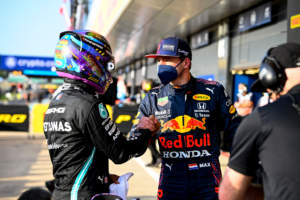Up Next

In the emphatic dismissal of Red Bull’s petition to review Lewis Hamilton’s British Grand Prix penalty, the detail of a “re-enactment” performed by Alex Albon stood out.
Red Bull launched a case to revisit Mercedes driver Hamilton’s 10-second time penalty at Silverstone, which was issued for being “predominantly” to blame for the collision that ended Max Verstappen’s race and left Red Bull with a $1.8million repair bill.
However, Red Bull has failed at the first hurdle as the stewards concluded the supposed new evidence provided “clearly” didn’t satisfy the requirements to merit a review.
This was because Red Bull’s submissions were either repackaged GPS data that was known at the time, or simulations of its own making – including, according to the stewards, “a re-enactment of Hamilton’s lap one line based on a lap allegedly driven by another driver”.
Red Bull test and reserve driver Albon was on Pirelli tyre test duty after the British GP, but that took place on Tuesday July 20.
The stewards noted that Albon completed this lap at Silverstone on Thursday July 22 – the same day Red Bull had released footage of a day he had conducted driving the 2019 RB15.
Jump onboard with @Alex_Albon for a 𝘃𝗲𝗿𝘆 𝘀𝘂𝗻𝗻𝘆 tour around Silverstone 😍☀️ pic.twitter.com/LKYbOH69AM
— Red Bull Racing Honda (@redbullracing) July 22, 2021
While it is not yet known if Red Bull completed that day solely with the purpose of re-enacting Hamilton’s line in the incident, based on the limited information provided by the stewards it was used at least partly for this purpose.
Teams are required “where possible” to inform the FIA of a planned test with a “previous car” at least 72 hours before it starts, which in this case would have been on Monday after the British GP.
Within that, teams must communicate the nature of the test. So, if it was pre-planned, and Red Bull did have to notify the FIA in advance, it’s possible the FIA knew that this re-enactment would be part of the remit – although disclosing such specific information may not have been necessary.
Regardless, using the 2019 car would have given Red Bull two clear benefits for such an exercise.
First, unlike the so-called filming days that allow teams a couple of 100km runs with current cars, testing of a so-called “previous car” (something from two seasons prior, or older) is free from any mileage restrictions. That would give Albon as many attempts as required to complete the re-enactment.
Second, testing of previous cars falls under the “Heritage Asset Activities” definition in the new-for-2021 financial regulations, which means it is exempt from the budget cap. So Red Bull could commit to this work without it coming out of its restricted annual spending.
A team of Red Bull’s means therefore had ample opportunity to complete the re-enactment. But what about the motive?
The moment of impact between Hamilton and Verstappen 👀#BritishGP 🇬🇧 #F1 pic.twitter.com/kxbV5xPYPt
— Formula 1 (@F1) July 18, 2021
While the specifics of the exercise are still to be established, the purpose is likely to be supporting Red Bull’s theory that Hamilton’s attempted pass on Verstappen would have ended with the Mercedes going off-track had the two cars not made contact.
Red Bull and Verstappen have contested that Hamilton’s angle of entry and speed into Copse meant he was guaranteed to run wide and hit Verstappen’s car.
Employing Albon to try to replicate Hamilton’s execution of the corner on lap one and then mapping the trajectory – without the contact Hamilton suffered – was presumably an effort to ‘prove’ this.
Whatever Red Bull found was sufficient for it to consider worth committing to the petition, which was lodged the following day on Friday July 23, as well as including the Albon lap as evidence.
However, the lap is irrelevant in the eyes of the stewards, and was unsurprisingly not deemed significant and new, nor was it “discovered” but rather “created”.
And that’s before getting into the specifics of why a different driver in a 2019 Red Bull and on ‘demonstration’ Pirelli tyres would not produce an exact replica of what Hamilton did in a 2021 Mercedes.
Even if Red Bull could have conclusively proved Hamilton would not have made the corner, that is all it would prove. It would not indicate intent, nor would it achieve anything beyond reinforcing the original stewards’ decision that Hamilton was the guilty party.
So, while some elements of the re-enactment can be easily explained, one still needs to be answered – what exactly was Red Bull trying to achieve with this?
The same question may also be asked of the petition itself, given the nature of the stewards’ dismissal.






